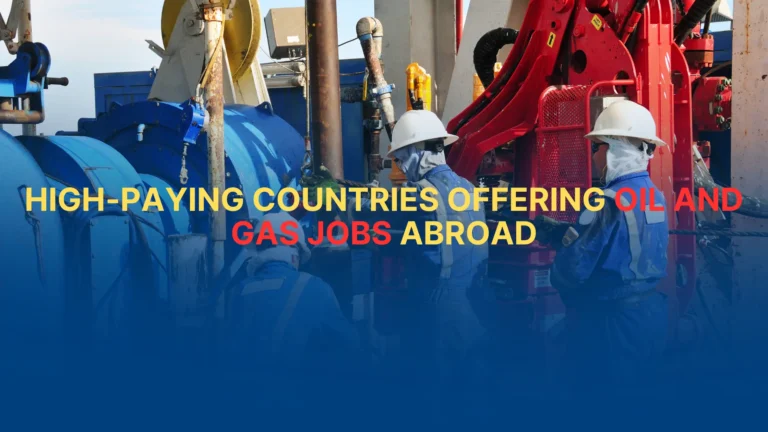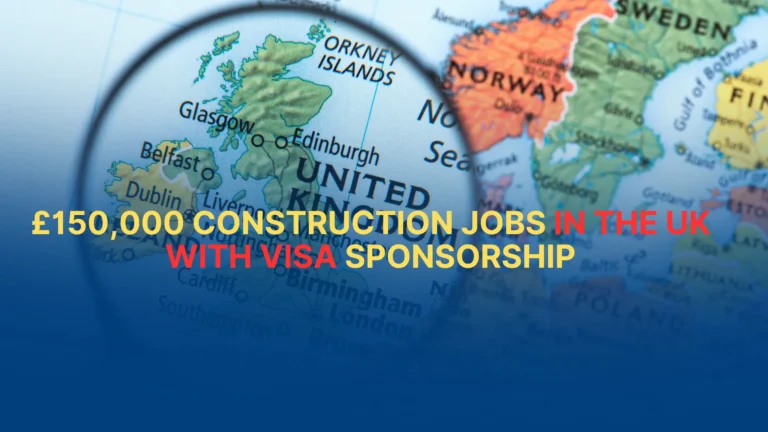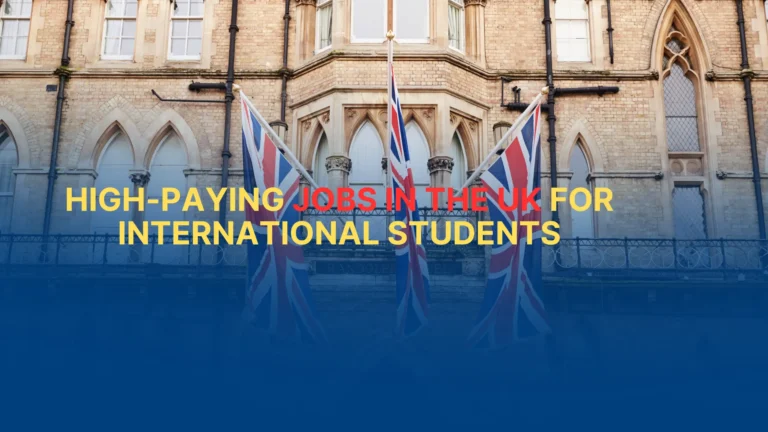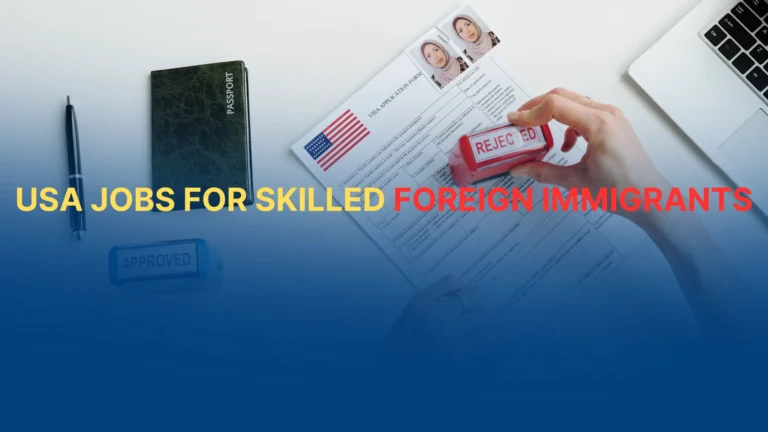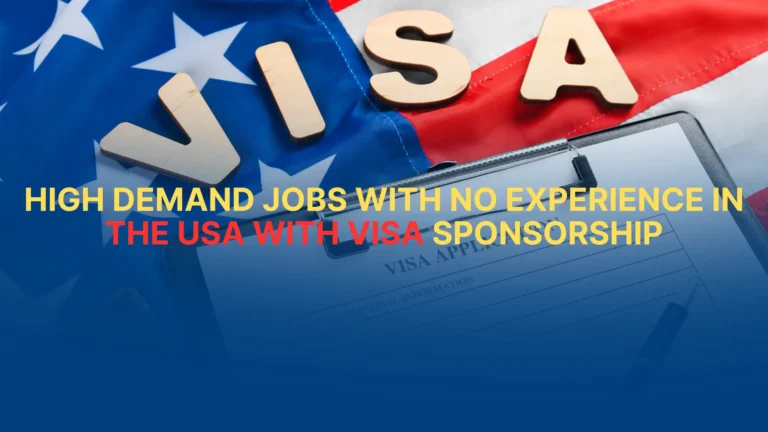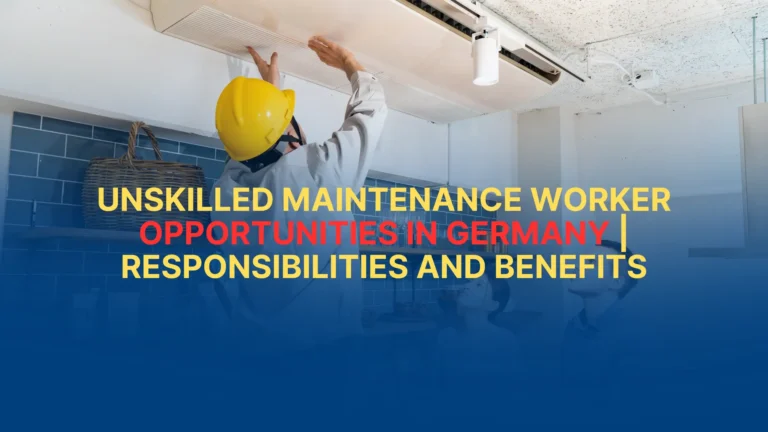Top Companies Offering Visa Sponsorship for Foreign Workers in Canada
Canada has continued to be a top destination for foreign professionals, skilled workers, and tradespeople seeking long-term job opportunities and a clear path to permanent residency. The country’s stable economy, high quality of life, and demand for labor in key industries such as healthcare, information technology, engineering, agriculture, and construction have made it an ideal place to live and work.
For many skilled professionals around the world, the concept of visa sponsorship offers the most direct route to legally working in Canada. Employers across various provinces are actively hiring international workers to fill critical labor shortages, and visa sponsorship is a legal mechanism that allows companies to bring in foreign talent.
The significance of finding the right visa-sponsored job in Canada cannot be overstated. It not only paves the way for legal employment but also increases the chances of settling permanently in the country.
The Canadian government supports employer-sponsored immigration programs because it helps maintain a steady influx of labor to fill essential positions that cannot be met through local recruitment alone. This is particularly true in smaller provinces and remote regions where the workforce is aging or insufficient to meet economic needs.
Job seekers from developing countries, including Nigeria, India, Pakistan, the Philippines, and parts of Eastern Europe, are among the largest beneficiaries of Canada’s visa sponsorship programs.
These opportunities are not just limited to highly educated individuals; many companies offer visa sponsorship for general labor roles, caregivers, truck drivers, and farm workers.
As long as a job is supported by a legitimate Labor Market Impact Assessment (LMIA), employers in Canada are authorized to sponsor eligible candidates from outside the country.
Understanding how visa sponsorship works in Canada, knowing where to search, and meeting the required qualifications are all crucial elements that determine success.
This guide provides a professional and detailed breakdown of what visa sponsorship in Canada entails, the types available, the process of securing a sponsored role, and the top companies that are currently offering such positions to international applicants.
What is the Visa Sponsorship for Foreign Workers in Canada all About?
Visa sponsorship in Canada refers to a legal arrangement where a Canadian employer takes responsibility for hiring a foreign national by providing the necessary documentation and employment offer to facilitate their entry into the country.
It involves the employer applying for a Labor Market Impact Assessment (LMIA) to prove that no Canadian citizen or permanent resident is available to fill the position. Once the LMIA is approved, the employer issues a formal job offer, which the foreign worker uses to apply for a work permit.
This system plays an integral role in Canada’s immigration framework. It helps maintain economic growth by addressing gaps in the labor market, especially in industries like healthcare, skilled trades, manufacturing, hospitality, and logistics.
Visa sponsorship is not limited to temporary employment; it often serves as the foundation for long-term immigration. Foreign workers sponsored by companies can later apply for permanent residence through pathways like the Provincial Nominee Program (PNP) or the Canadian Experience Class (CEC) under the Express Entry system.
A critical element of visa sponsorship is compliance. Employers must demonstrate that they meet government standards regarding wages, working conditions, and employee treatment.
This ensures that foreign workers are not exploited or underpaid. The government monitors these arrangements closely, and failure to meet the required conditions can lead to penalties for employers and visa rejection for applicants.
The visa sponsorship process is generally employer-driven. This means that the job seeker must first secure a job offer from a Canadian company willing to go through the sponsorship process.
While some employers only hire workers who are already in Canada, many others specifically target international talent due to specialized skill requirements or labor shortages.
For job seekers, understanding the process, knowing which industries regularly sponsor foreign workers, and ensuring that your qualifications align with Canadian labor standards are essential. Having a clear employment offer backed by an LMIA significantly increases your chances of receiving a work visa and legally working in Canada.
Types of Visa Sponsorship for Foreign Workers in Canada
Visa sponsorship options in Canada are diverse, and they vary depending on the nature of employment, industry demands, and immigration goals of the applicant. The most common and widely recognized form is the employer-sponsored work visa, particularly under the Temporary Foreign Worker Program (TFWP).
This program allows Canadian employers to hire international workers for positions they are unable to fill locally. It requires a positive LMIA from Employment and Social Development Canada (ESDC), confirming that hiring a foreign national will not negatively affect the local labor market.
Another type of visa sponsorship falls under the International Mobility Program (IMP). Unlike the TFWP, the IMP does not require an LMIA. Instead, it focuses on broader economic and cultural benefits to Canada.
Programs under the IMP include intra-company transfers, open work permits for spouses of skilled workers or international students, and agreements under international trade deals like NAFTA (now CUSMA). While the IMP pathway is less burdensome for employers, it applies only to specific cases.
The Provincial Nominee Program (PNP) is also a critical route for visa sponsorship. Through this program, Canadian provinces nominate foreign workers for permanent residence based on local labor needs.
Many provinces have employer-driven streams where sponsorship plays a central role. For instance, provinces such as Manitoba, Saskatchewan, and Nova Scotia actively encourage employers to recruit from abroad and provide sponsorship under their PNP streams.
For candidates in specialized professions like healthcare, engineering, or IT, there are industry-specific programs where companies and professional bodies work together to sponsor talent.
In sectors facing extreme shortages, such as trucking, caregiving, or agriculture, employers often receive government support to hire foreign labor quickly through simplified sponsorship procedures.
Visa sponsorship is also available in the form of post-graduation work permits for international students, where Canadian educational institutions essentially act as sponsors by providing the foundation for future employment. Over time, many of these graduates transition to permanent residency with the help of Canadian employers.
Understanding the different types of sponsorship options helps foreign workers choose the right path and approach potential employers accordingly. Each program has its own eligibility requirements, application procedures, and processing times, so aligning your skills and experience with the appropriate visa sponsorship pathway is essential for a successful move to Canada.
How to Find Visa Sponsorship for Foreign Workers in Canada
Finding a visa-sponsored job in Canada requires strategy, research, and persistence. It starts with identifying companies that are open to hiring international workers and willing to support them through the sponsorship process.
The best approach involves targeting job portals, recruitment agencies, and Canadian government platforms that list open positions specifically designed for foreign applicants.
Job portals such as Job Bank Canada, Indeed Canada, and Workopolis allow you to filter job listings by visa sponsorship availability. Employers who are open to international hiring typically state so clearly in the job description.
LinkedIn has also become a powerful tool in this process, allowing candidates to connect directly with HR managers and recruiters of Canadian companies. Many employers actively seek talent from abroad through networking events and international job fairs.
Government-sponsored programs like the Atlantic Immigration Program (AIP) and Rural and Northern Immigration Pilot (RNIP) work with designated employers who are approved to hire foreign nationals.
These employers are vetted by immigration authorities and are legally authorized to sponsor workers, making them a reliable and transparent option for job seekers abroad.
In addition to job portals, many international recruitment agencies specialize in Canadian visa sponsorship jobs. These agencies bridge the gap between Canadian employers and foreign professionals, helping both parties with documentation, interviews, and compliance. However, it’s crucial to ensure that the agency is licensed and credible before proceeding.
You should also look for companies that have historically hired foreign workers through LMIA-supported roles. These companies often appear in government databases and are more likely to continue hiring international staff. Reaching out to community groups and professional networks in Canada can also lead to job referrals and connections with potential sponsors.
Finding visa-sponsored employment also involves preparing a Canadian-standard resume and cover letter. Tailor each application to the employer’s needs and clearly state your willingness to relocate and your eligibility for sponsorship. Highlighting your industry certifications, language skills, and relevant experience can give you an edge over other candidates.
While the competition can be intense, thousands of foreign workers are successfully hired each year through sponsorship programs. By using the right tools and applying to the right organizations, job seekers can significantly increase their chances of securing employment in Canada with visa support.
General Requirements for Visa Sponsorship for Foreign Workers in Canada
Visa sponsorship in Canada involves a range of eligibility criteria that both the employer and the foreign worker must meet. These requirements are in place to ensure that the employment relationship is legitimate, mutually beneficial, and aligned with Canadian labor laws.
The first and most essential requirement is a valid job offer from a Canadian employer willing to sponsor your visa. The job offer must be supported by an LMIA, unless the position qualifies under the International Mobility Program which allows LMIA exemptions for specific categories.
For the job to qualify for visa sponsorship, the employer must demonstrate that they were unable to fill the position with a Canadian citizen or permanent resident. This involves advertising the job in Canada for a specific period, offering competitive wages, and ensuring the working conditions meet Canadian standards. The employer must also be financially capable of paying the worker and have a clean record with Canadian labor regulations.
From the applicant’s side, having the appropriate skills, qualifications, and work experience is mandatory. Depending on the position, you may also be required to have trade certifications, professional licenses, or Canadian equivalency of your foreign degree. In many cases, English or French language proficiency is also assessed through tests such as IELTS or TEF.
Applicants must also be able to pass medical and security checks. Canada requires all foreign workers to undergo medical examinations, especially those working in healthcare, childcare, or food services. Additionally, a clean police background check from your home country and any country you’ve resided in for more than six months is required.
Other general requirements include having a valid passport, sufficient funds to support yourself upon arrival, and the ability to adapt to Canadian society. In some cases, family members can be included in the application, allowing spouses and children to join the principal applicant.
The documentation required includes a formal job offer letter, an LMIA approval (if applicable), proof of qualifications, identification documents, and any certifications related to the occupation. All these must be submitted with accuracy and completeness to avoid visa delays or rejections.
Meeting these requirements does not guarantee visa approval, but it significantly improves your chances. Canadian immigration authorities assess each case carefully, and having a strong application backed by a reliable sponsor can lead to long-term employment and eventually permanent residency.
Application Guide for Visa Sponsorship for Foreign Workers in Canada
Applying for a job in Canada with visa sponsorship involves a detailed process that requires accuracy, proper documentation, and adherence to immigration regulations.
It is not enough to simply secure a job offer; the entire application journey must align with both the employer’s responsibilities and the worker’s legal obligations under Canadian law. Each step must be handled professionally to avoid delays or denials.
The first step in this process is obtaining a valid job offer from a Canadian employer. This offer must include all relevant details such as job title, salary, duration of employment, and job responsibilities.
Once you receive the job offer, the employer initiates the process of applying for a Labour Market Impact Assessment (LMIA) if required. The LMIA is issued by Employment and Social Development Canada (ESDC) and acts as proof that hiring a foreign worker will not harm the Canadian labor market.
Once the LMIA is approved, the employer provides a copy of the LMIA and the job offer letter to the foreign worker. With these two documents, the applicant can now apply for a Canadian work permit. The application can be submitted online or through a visa application center, depending on the applicant’s country of residence.
At this stage, the applicant must prepare several supporting documents including a valid passport, updated resume, educational credentials, proof of work experience, language test results (if applicable), and any professional licenses or certificates relevant to the job.
Alongside the primary documents, applicants must also submit biometric data, undergo a medical examination, and provide a police clearance certificate. These checks ensure the applicant poses no health or security risk to Canada. Processing times vary depending on the applicant’s home country and the type of work permit being issued, but it generally takes between four to sixteen weeks.
For those applying under the International Mobility Program (IMP), the process is slightly different as LMIA is not required.
Instead, the employer registers the job offer through the Employer Portal and pays the compliance fee. The worker then applies for a work permit using the offer of employment number provided by the employer.
After submitting your application, it’s important to monitor the application portal and respond to any additional document requests from Immigration, Refugees and Citizenship Canada (IRCC).
Once your application is approved, you will receive a Port of Entry (POE) letter of introduction. This document must be presented to Canadian border officials upon arrival. You’ll also be issued a work permit at the port of entry if everything is in order.
Understanding and carefully following each step in this process increases your chances of success and smooth entry into the Canadian workforce under a valid work visa. Accurate documentation, compliance from both parties, and timely communication with Canadian authorities are all critical in this regard.
Top Companies Offering Visa Sponsorship for Foreign Workers in Canada
Several companies in Canada have gained recognition for consistently offering visa sponsorship to foreign workers due to ongoing labor shortages in specific industries.
These companies have established hiring structures that accommodate international applicants and have experience in handling LMIA processes or working under the International Mobility Program. Being aware of these employers significantly improves your chances of finding sponsored work in Canada.
One of the top companies known for hiring foreign talent is Magna International, a leading automotive manufacturing firm based in Ontario. Magna often hires skilled tradespeople, engineers, and technicians from abroad to support its global production systems.
The company has a history of LMIA-approved job offers and works with immigration consultants to support foreign workers throughout the visa process.
Maple Leaf Foods, a major player in Canada’s food processing sector, also offers visa sponsorship in roles ranging from general laborers to skilled meat cutters. Given the industry’s consistent demand for workers, especially in rural locations, Maple Leaf Foods actively recruits internationally to fill gaps.
In the agriculture and agribusiness space, GreenTech Resources stands out. This recruitment agency works directly with farm employers across Saskatchewan and Alberta to connect foreign workers with LMIA-supported farm and greenhouse jobs. Roles include harvesters, packers, and equipment operators, many of which come with employer-sponsored visa packages.
For those in the healthcare field, SE Health and Bayshore HealthCare are two employers that regularly sponsor foreign caregivers and nurses.
These companies operate nationwide and frequently hire internationally trained healthcare professionals through sponsorship schemes. Given the country’s aging population and healthcare labor gaps, demand for nurses and support workers is growing year after year.
Scotiabank, one of Canada’s top five banks, also supports international recruitment in fields like IT, cybersecurity, and finance. While not all roles are sponsored, departments experiencing skill shortages are more open to hiring foreign experts. Similarly, Shopify and Amazon Canada are major employers in the tech and logistics sectors that have provided LMIA-based job offers to skilled foreign professionals.
The construction and transportation industries also have key players like Pomerleau Construction and Day & Ross Trucking, both known to offer visa sponsorship for skilled tradespeople and long-haul drivers, respectively. These companies benefit from simplified LMIA procedures due to labor shortages in these sectors.
While these companies are not the only ones hiring from abroad, they represent sectors with the highest likelihood of sponsorship.
Applying directly through their official career portals and specifying your willingness to work under a visa sponsorship arrangement increases your chances of being shortlisted. Always ensure that the employer is LMIA-authorized or listed under Canada’s designated employers if applying through specific immigration programs.
Steps to Secure Visa Sponsorship for Foreign Workers in Canada
Securing a job in Canada with visa sponsorship requires a combination of preparation, targeted applications, and clear understanding of immigration procedures. The journey begins with thorough self-assessment to determine whether your skills, qualifications, and work experience align with Canadian labor market needs.
If you work in industries like healthcare, information technology, engineering, agriculture, construction, or logistics, your chances of finding sponsored work are significantly higher.
Once you identify your eligibility, the next step is to prepare a professional resume and cover letter tailored to Canadian hiring standards. Canadian resumes emphasize concise information, work experience in reverse chronological order, and qualifications relevant to the specific role. Your cover letter should express your intent to relocate, availability for sponsorship, and why you are a good fit for the position.
Now, focus your job search on trusted platforms such as Job Bank Canada, Indeed, and Glassdoor. Apply only to companies known to sponsor foreign workers.
Filter your searches with terms like “LMIA available,” “visa sponsorship,” or “foreign worker hiring.” Visit employer websites directly to apply through their official career sections, and sign up for job alerts from immigration-focused job boards.
Networking is equally important. Use LinkedIn to reach out to hiring managers and recruiters in your field. Attend virtual job fairs, especially those hosted by Canadian provinces and federal immigration programs like the Atlantic Immigration Program or RNIP. These fairs often feature designated employers authorized to sponsor foreign nationals.
Once you receive a job offer, confirm that the employer is willing to apply for an LMIA or already qualifies under the International Mobility Program. If the employer agrees, they will initiate the LMIA application or register the job in the Employer Portal. After the LMIA approval or job offer registration, you can proceed with your work permit application.
Make sure you gather all required documents—passport, educational certificates, proof of experience, language test results, and police clearance—and submit a complete application to Immigration, Refugees and Citizenship Canada (IRCC). Monitor your application for updates and respond promptly to any requests for additional information.
If approved, you’ll receive a letter of introduction, which you present to border officials when you arrive in Canada. A work permit is then issued at the point of entry. From that moment, you are legally permitted to work in Canada under the conditions outlined in your permit.
Remember, successful visa sponsorship is not just about getting the job offer—it’s about following through with each requirement, staying informed about immigration policies, and presenting yourself as a professional candidate who adds value to the Canadian workforce.
